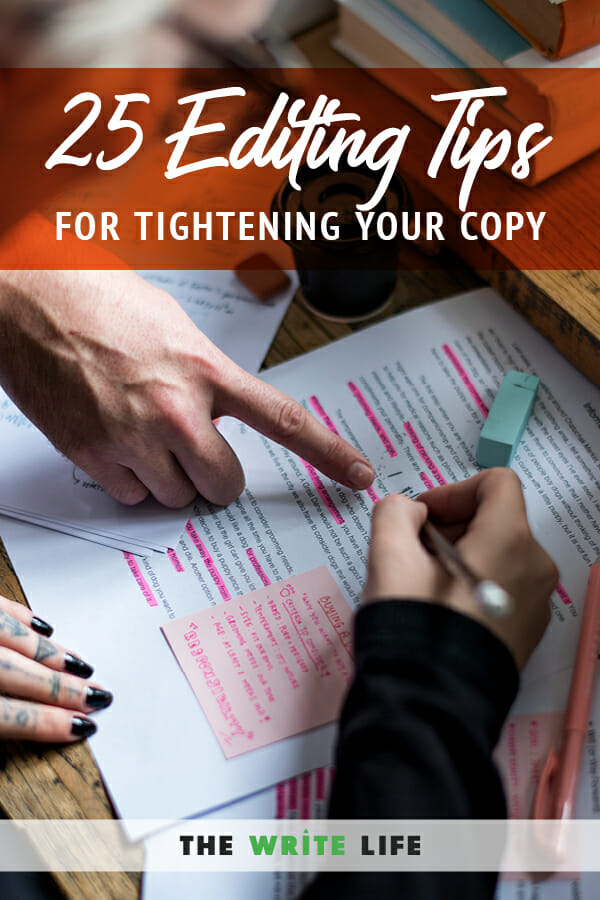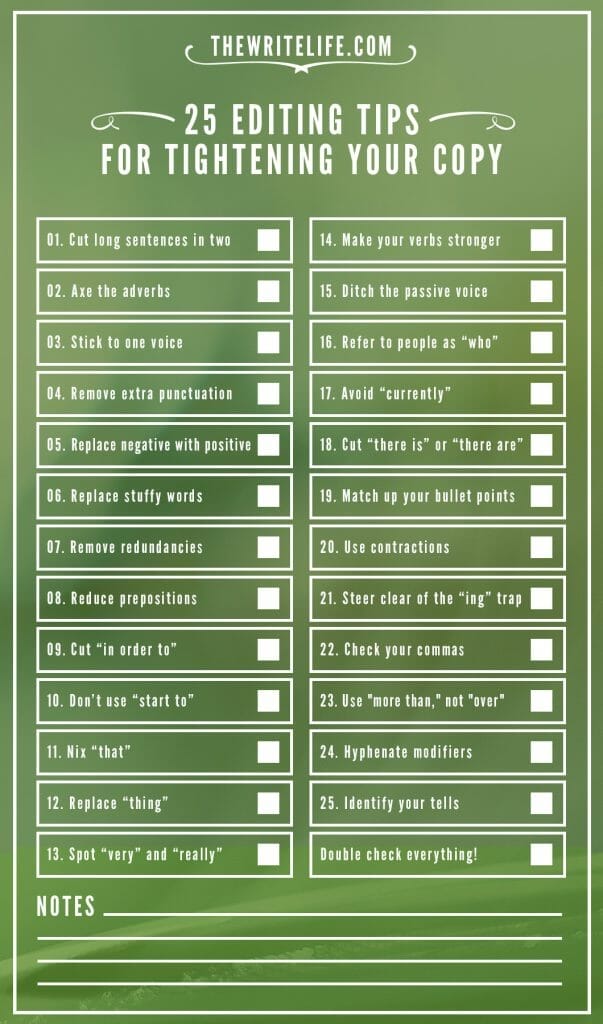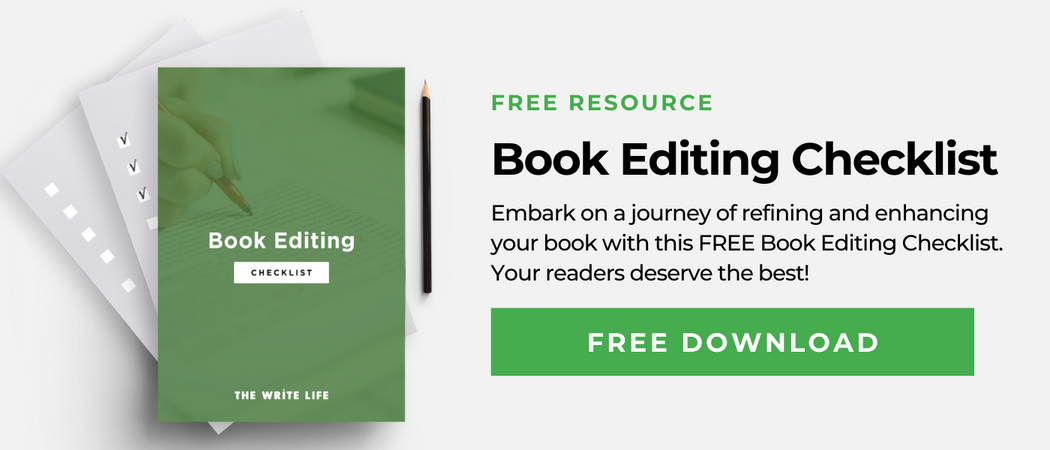Writers rarely spit out their best copy on the first draft. If you meet a writer who claims to have the secret for doing so, please let the rest of us know!
First drafts — and second drafts and sometimes thirds — exist to hash your ideas out on paper. After you’ve revised your book, story, blog post or article until you can revise no more, you just hand it off to your editor to clean up, right?
Well, that’d be ideal. But most of us don’t have the luxury of hiring an expensive editor to review our personal blog post It might even be hard to spend the money for a book editor. And since procrastination is the writer’s best friend, you might not even have time to even ask a fellow writer pal take a quick peek for errors.
And so, in some cases, it falls to you to be your own editor.
How to edit: Follow these copyediting tips
Even if you don’t want to become an editor, you’ve got to learn how to edit. Is it really possible edit your own work when all the words you just finished writing are so precious? Yes! It can be done — and for the sake of making your writing stand out, it must be done.
So pull up your most recently saved draft, and get to work. To make it easy for you, we’ve added to the bottom of this list a downloadable and printable PDF that summarizes these copyediting tips into a checklist.
Here’s how to edit your own work.
1. Cut long sentences in two
I’m not talking about run-on sentences. Many long sentences are grammatically correct. But long sentences often contain several ideas, so they can easily lose the reader’s focus because they don’t provide a break, leading readers to get stuck or lose interest, and perhaps the reader might get bored and go watch TV instead.
See what I mean? If you spot a comma-heavy sentence, try to give each idea its own sentence.
2. Axe the adverbs (a.k.a. -ly words)
Adverbs weaken your copy because these excess words are not truly descriptive. Rather than saying the girl runs quickly, say she sprints. Instead of describing the cat as walking slowly, say he creeps or tiptoes. The screen door didn’t shut noisily, it banged shut.
Find a more powerful verb to replace the weak verb + weak -ly adverb combo.
3. Stick to one voice
Sometimes it’s necessary to use both first and second person, but that can be jarring for readers. For example, you might start your introduction talking about yourself, then switch halfway through the piece and start addressing the reader. Try to stick to “I” voice or “you” voice throughout one piece of writing.
And if you must switch, start with one and finish with the other. Don’t move back and forth between the two. Your readers will get lost.
4. Remove extra punctuation
A powerful hyphen here and a thought-provoking semicolon there can be effective. But a piece of writing littered with all sorts of punctuation — parentheses, colons, ellipses, etc. — doesn’t flow well.
Oftentimes, you can eliminate these extra pieces of punctuation with commas or by ending a sentence and starting a new one. And that makes your writing that much stronger.
5. Replace negative with positive
Instead of saying what something isn’t, say what it is. “You don’t want to make these mistakes in your writing” could be better stated as, “You want to avoid these mistakes in your writing.” It’s more straightforward.
If you find negative statements in your writing that contain don’t, shouldn’t, can’t or another such word, find a way to rewrite them without the “not.” That will probably mean you need to find a more powerful verb.
6. Replace stuffy words with simple ones
Some people think jargon makes their writing sound smart, but you know better. Good writing does not confuse readers. If they need to grab a dictionary to finish a sentence, your writing has room for improvement.
To get your point across, use words people are familiar with. The English language has thousands of words. You can certainly find a shorter or more common word in your thesaurus than a jargony one.

7. Remove redundancies
You don’t need to say the exact same thing with two words. Did you catch the redundant words in that sentence? Here’s a better version: you don’t need to say the same thing with two words.
Brand new, advance planning, basic necessities… the list of these common phrases is longer than this blog post. Check out Thoughtco.com’s 200 Common Redundancies and then start snipping!
Sometimes sneaky redundancies are separated by an “and.” If you say your sentences are straightforward and to-the-point, they are neither. You don’t need both words. Your sentences are straightforward. Or, your sentences are to-the-point.
8. Reduce prepositions
Though prepositions (of, in, to, for, etc.) are helpful little words, they make sentences more lengthy because they cannot stand alone. Prepositions need lots of friends. By cutting the preposition and the words that follow, you can cut three, four or even five words. Sometimes a prepositional phrase can be replaced with just one more direct word, or cut completely.
An easy way to cut prepositions is to look for opportunities to make something possessive. The car of your neighbor is really just your neighbor’s car.
9. Cut “in order to”
You never need it. If you’re going to the kitchen in order to make a sandwich… Your sentence could be tighter. Because you’re really going to the kitchen to make a sandwich.
That “in order to” makes it take a millisecond longer to arrive at the meaty part of the sentence, which means your story is dragging more than it needs to.
10. Don’t use “start to”
Did you start to walk the dog, or did you walk the dog? Is the car starting to roll down the hill, or is it rolling down the hill?
“Start to” is a more difficult phrase to deal with than “in order to,” because sometimes you do need it. But more likely than not, you don’t.
Rather than making “start” the active verb, use the verb that’s actually more active — like walking or rolling — to tell your story.
11. Nix “that”
In about five percent of your sentences (total guess from the grammar police), “that” makes your idea easier to understand. In the other 95 percent, get rid of it!
“I decided that journalism was a good career for me” reads better as “I decided journalism was a good career for me.”
12. Replace “thing” with a better word
Usually when we write “thing” or “things,” it’s because we were too lazy to think of a better word. In every day life, we may ask for “that thing over there,” but in your writing, calling anything a “thing” does not help your reader.
Try to replace all “thing” or “things” with a more descriptive word.
13. Try really hard to spot instances of “very” and “really”
This is a very difficult one to remember. I almost never get it right, until I go back through my copy, and the word jumps out at me, and then I change the sentence to “This is a difficult one to remember.” Because really, how much is that “very” helping you get your point across?
It doesn’t make the task sound more difficult. Same thing with “really.” It’s not a “really” difficult tip to remember. It’s simply a difficult tip to remember. Got it?
14. Make your verbs stronger
“Make” is sometimes used in the same way as “start to,” in place of what could be a stronger verb.
For example, I first titled this post, I wrote “25 ways to make your copy stronger.” When I re-read it, I realized the verb wasn’t strong.
I’d used “make” as the verb, when it doesn’t tell the reader much at all. So I changed the title to “25 ways to strengthen your copy.” Eventually I realized “tighten” was an even better verb.
15. Ditch the passive voice
Passive voice sticks out to editors, but it can be difficult to notice in your own writing. Learning how to identify it and fixing these instances will make your writing stronger.
Here’s an example of passive voice: “The door was left open.”
To change that sentence to active voice, it would look like this: “Someone left the door open” or “He left the door open.” The idea is to be clear about who or what is executing the action.
If you want to get good at this, Self-Publishing School has a solid post explaining passive voice.
16. Refer to people as “who” not “that”
John is the guy who always forgets his shoes, not the guy that always forgets his shoes.
It’s easy to make this mistake because “that” has become acceptable in everyday conversations. But it’s more noticeable when it’s written down.
17. Avoid “currently”
Pro copywriting tip: “Currently” is always redundant.
Don’t write: “Tom Jones is currently a communications director.” Tom Jones is a communications director at that moment. You don’t need “currently” to clarify. Just get rid of it.
18. Eliminate “there is” or “there are” at the beginning of sentences
This is often a symptom of lazy writing. There are lots of better, more interesting ways to start sentences.
See how easy it is to make this mistake? Instead of starting a sentence with “there is,” try turning the phrase around to include a verb or start with you.
For example, replace the sentence above with “Start your sentences in a more interesting way.” If your copy includes a lot of phrases that begin with “there is” or “there are,” put some time into rewriting most of them.
19. Match up your bullet points
Bullet points are a popular and effective way to organize complex ideas. Just make sure your bullets correspond to one another.
Too often, writers mix and match mistakes with what you should do or transition to shoulds halfway through the post — which only confuses the reader.
If your piece is called 3 Career Mistakes You Don’t Want to Make, here’s a bullet point that works:
-
Forgetting to tailor your resume each time you apply for a job
Here’s one that doesn’t work (because it’s not actually a mistake — the writer accidentally switched to what you should do):
-
Make sure you tailor your resume
You can turn most any idea into a tip by adding a verb. For example: “Remember that sitting on your head helps you write better.” Make your bullet points consistent and your writing will read more smoothly.
20. Use contractions
Which sounds more personable: I am heading to the market that is close to my house, or I’m heading to the market that’s close to my house?
Contractions make your writing sound friendlier, like you’re (not you are) a real person. And that makes it easier to connect with readers.
Contractions can also make your post easier to read and comprehend. So go out of your way to include them in your posts! Your editor will thank you.
21. Steer clear of the “ing” trap
“We were starting to …” or “She was skiing toward …” Whenever you see an “ing” in your copy, think twice about whether you need it — because you probably don’t.
Instead, get rid of “were” or “was,” then eliminate that “ing” and replace it with past tense: “We started to …” or “She skied toward …” Pruning excessive “ings” makes your writing clearer and easier to read.
22. Check your commas with “that” and “which”
When used as a descriptor, the word “which” takes a comma. But the word “that” doesn’t.
For example: “We went to the house that collapsed yesterday” or “We went to the house, which collapsed yesterday.”
Confused about when to use “that” vs. “which?” Grammarly offers a great explanation.
23. Replace “over” with “more than” for numbers
Over 200 people did not like your Facebook page — more than 200 people did.
Of course, everyone will know what you mean if you use “over.” In fact, the AP Styleguide, which many journalists follow as the bible of style, announced a few years ago that “over” is now acceptable in place of “more than.”
But if we’re being really nit-picky, using “more than” instead is still one a little detail that will help your writing shine.
24. Hyphenate modifiers
Whenever you modify a noun with more than one word, you need a hyphen. Lots of people don’t follow this rule, so it’s a great way to show you actually walk the walk.
That means you need a hyphen if you’re writing about full-time work. But you don’t need one if you’re working full time.
Got it? The exception: No need to hyphenate modifiers that end in “ly.” Those are OK on their own. So your newly hired employee doesn’t need that hyphen.
25. Identify your tells
No matter how good of a writer you are, when you sit down to write a first draft, you have a tendency to spit out sentences in a certain way or use certain words. The more familiar you become with editing your own copy, the more quickly you should be able to pick up on your tells. And, the more ruthless you can be to eliminate them from your writing.
“Start to” plagued me while writing my book; I made the “start to” mistake again and again. But once I knew to look for it during revisions, I was able to correct it.
(Hint: If this is a problem for you, try using Word’s or Google Doc’s search function to look for “start.” You’ll catch each one, so you can evaluate them individually.)
Bonus: An editing checklist for how to edit your work (it’s printable!)
Since we first published this post back in 2013, so many of you mentioned bookmarking and sharing the post that we whipped up a pretty editing checklist to go with it. It’s available to download and print.
Pin this baby up on the wall above your desk, whip out your red pen, and get to work! Your blog post, feature article, or novel will be tighter and stronger in no time as you learn how to make edits.
If you want to download or print the editing checklist, click on it to bring up the full size.

This is an updated version of a story that was previously published. We update our posts as often as possible to ensure they’re useful for our readers.
Some of these tips originally ran on Copyblogger and AlexisGrant
Photo via Lamai Prasitsuwan/ Shutterstock








